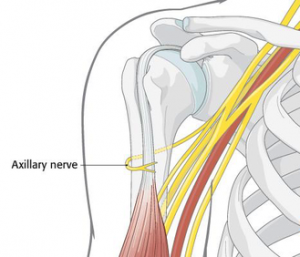One of the great benefits of being a physical therapist is knowing who the best doctors are for any musculoskeletal issue you may encounter. The orthopedic surgeon that I’m seeing is someone who I refer patients to when I feel they need a consultation. Although I have never met him in-person I feel like I have because I’ve seen so many patients from him and sent so many to him over the years. I always say, “If it was my shoulder I would see Dr Favorito.” So now it’s time to put my money where my mouth is! I got an appointment for Tuesday, January 19.
At the orthopedic office, I started by getting several more X-rays–different views than the hospital took. Dr. Favorito is very thorough and is sure to view the joint from every possible angle. When he entered the exam room he said, “Well, I didn’t think THIS is how we’d be meeting!” And of course I agree! He took a thorough history and did an exam, gently checking sensation, muscle strength, and function in the injured shoulder.Axi

The sensation to light touch on my shoulder is very diminished and my deltoid muscle is very weak. This indicates damage to the axillary nerve, which wraps around the humerus and would have been overstretched with the dislocation. This should improve over time but it will be a very slow process as nerves are the slowest healing tissue in the body. On average, peripheral nerves like this one regenerate at a rate of one inch per month.Hill

The X-rays showed a Hill-Sachs lesion on the head of the humerus. This is a compression fracture on the back side of the humeral head (the “ball” part of this “ball and socket” joint) from where it impacted into the front of the glenoid (the “socket”) when it dislocated. Basically, it’s a dent in the humerus. This is a problem not just for the obvious reasons but also because it is more common to have a Bankart lesion when a Hill-Sachs lesion is present.
A Bankart lesion is the name for a tear that happens in the lower rim of the labrum, which is the ring of cartilage around the glenoid. It is 11 times more common in patients with a Hill-Sachs lesion. Once the labrum is torn, it’s much easier for the humerus to slip out of its socket. And that is something I NEVER want to experience again!
Dr Favorito sent me out with a much better sling and an order for an MRI, which is what we need to be able to see the labrum.
Read part 3 to see how the MRI turned out!